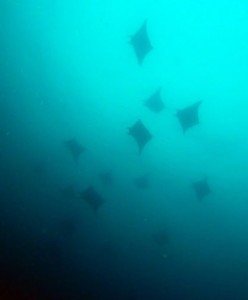Source: BBC News Image: David Jones
 A new study shows that devil rays plunge nearly 2km below the ocean surface, making some of the deepest and fastest dives ever observed in the sea. Scientists tracked 15 of the large, winged fish, previously thought to be surface dwellers, for several months. In between their icy dives, they appear to bask near the surface to warm up.
A new study shows that devil rays plunge nearly 2km below the ocean surface, making some of the deepest and fastest dives ever observed in the sea. Scientists tracked 15 of the large, winged fish, previously thought to be surface dwellers, for several months. In between their icy dives, they appear to bask near the surface to warm up.
The findings, published in Nature Communications, offer an explanation for a mysterious mass of blood vessels, thought to keep the ray’s brain warm. The front part of the animal’s skull is stuffed with a sponge-like mesh of large and small arteries. This network, called a rete mirabile, was described in the devil rays 30 years ago. The Mobula ray family, which includes these “flying” bentfin rays, were all thought to live near the surface
“It was a mystery as to why they had this system, which is a way of keeping brain activity high, even in a cold environment,” said Dr Simon Thorrold, an ocean ecologist at the Woods Hole Oceanographic Institution and the new paper’s lead author. The scientists who discovered the rete mirabile in devil rays were so baffled by its presence in a warm-water species that they even suggested it might be working in the opposite direction from usual, helping cool the brain while the rays basked in the sun. Dr Thorrold’s results appear to have solved that mystery. “We looked at the data and of course, it made complete sense,” he told BBC News. He believes the rays are feeding at the bottom of their remarkable dives, using a well-heated, active brain to forage for small fish that abound in deeper layers of the ocean.
To reveal the ray’s secret submarine lifestyle, Dr Thorrold and his colleagues tagged 15 Chilean devil rays (Mobula tarapacana) using special tags tethered to darts. “We actually jump in the water and tag them ourselves,” he said. “We take a polespear, we swim down and deploy the tag. The animal’s not restrained in any way.” The researchers don’t suffer either. “It’s pretty good work, right? Free-diving in the Azores.”
This autonomous Portuguese archipelago happens to be one of the best places to find these particular devil rays, since they congregate there in the summer, around the top of underwater mountains. But then, in the autumn, they disappear. “We had no idea where they were going,” said Dr Thorrold. “We had an idea that they were moving a long way, perhaps several thousand kilometres.” That was where the tags came in. These programmable gadgets recorded depth, light, temperature and position data for up to five months, before detaching themselves and bobbing to the surface, where they beamed their data back to the researchers via satellite. Perhaps unsurprisingly, the rays all headed south, with several being tracked almost as far as the equator.
This was the first time devil ray migration had been recorded and the distances were as much as 3,800km. But it was the other measurements that got the team excited.
“The first thing I looked at was the temperature data,” said Dr Thorrold, “and I saw temperatures of about 4C – and this is an animal that’s supposed to be living in the tropics! I suspected there was probably a mistake.” Devil rays travelled up to 3,800km from the Azores in the North Atlantic, where they were tagged . The depth data confirmed, however, that the freezing temperatures were a result of incredibly deep dives, typically lasting 60-90 minutes and reaching 1,848m beneath the waves. Very few fish, among them whale sharks, have been shown to dive this deep, and the all-time record (2,992m) is currently held by a mammal: the beaked whale. During the day, but not at night, the devil rays tend to loiter within 2m of the water surface for periods before and after their deepest expeditions. This suggests they are using the sun’s warmth to prepare and recover. One ray plunged below 1,400m on six consecutive days – behaviour that places these devil rays “right at the limit” of known diving behaviour, according to Dr Thorrold.
What is more, they were fast. The rays swam downward at up to 22km/h (13mph), which is much faster than sharks and whales typically descend. That speed is another surprise. Because the rays are negatively buoyant, they could simply allow themselves to sink, gliding with little effort to their deep-sea feast. “Our rays are swimming basically as hard as they can, straight down,” said Dr Thorrold. He believes this is another strategy for keeping warm. Heat generated by their muscles could be stored and used by the specialised brain blood supply, to keep brain function high in the icy depths. Dr Thorrold says the new findings highlight how little is known about these deeper ecosystems.
